An Attempted Utopia
The city of Shumen in Bulgaria is home to the country’s largest monument to the Founders of the Bulgarian State. An enormous, cathedral-like complex on the plateau above Shumen tells the story of the early Bulgarian rulers through a series of larger-than-life modernist sculptures.
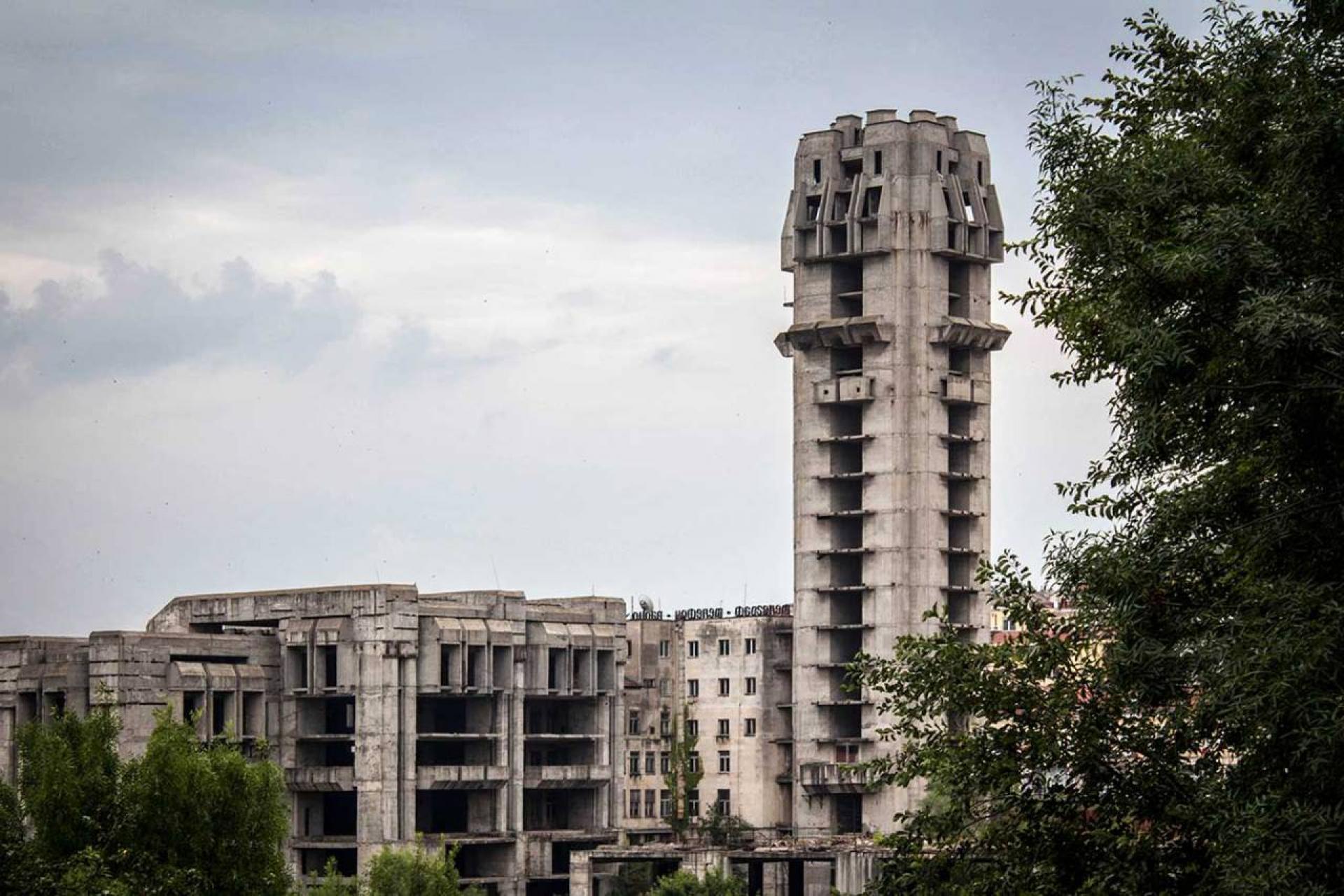
Shumen Central City Square (1988-1989), unfinished. Created by Ivan Sivrev, Elena Konyarska, Maya Petrova, and Tsvetan Vasilev; chief consultant architect Georgi Stoilov. | Photo © Darmon Richter
But while many other memorials built during the communist period have been doomed now to decay and obsolescence owing to their political symbolism – branded as they often are with hammers, sickles and stars – the Shumen monument, by focussing purely on the ancient past, has managed to remain relevant to, and loved by, its inheritors. Today this symbol of Bulgarian nationhood is better preserved than probably any other monument built during the 45 years of Bulgarian communism so many foreign visitors come to Shumen to marvel at it.
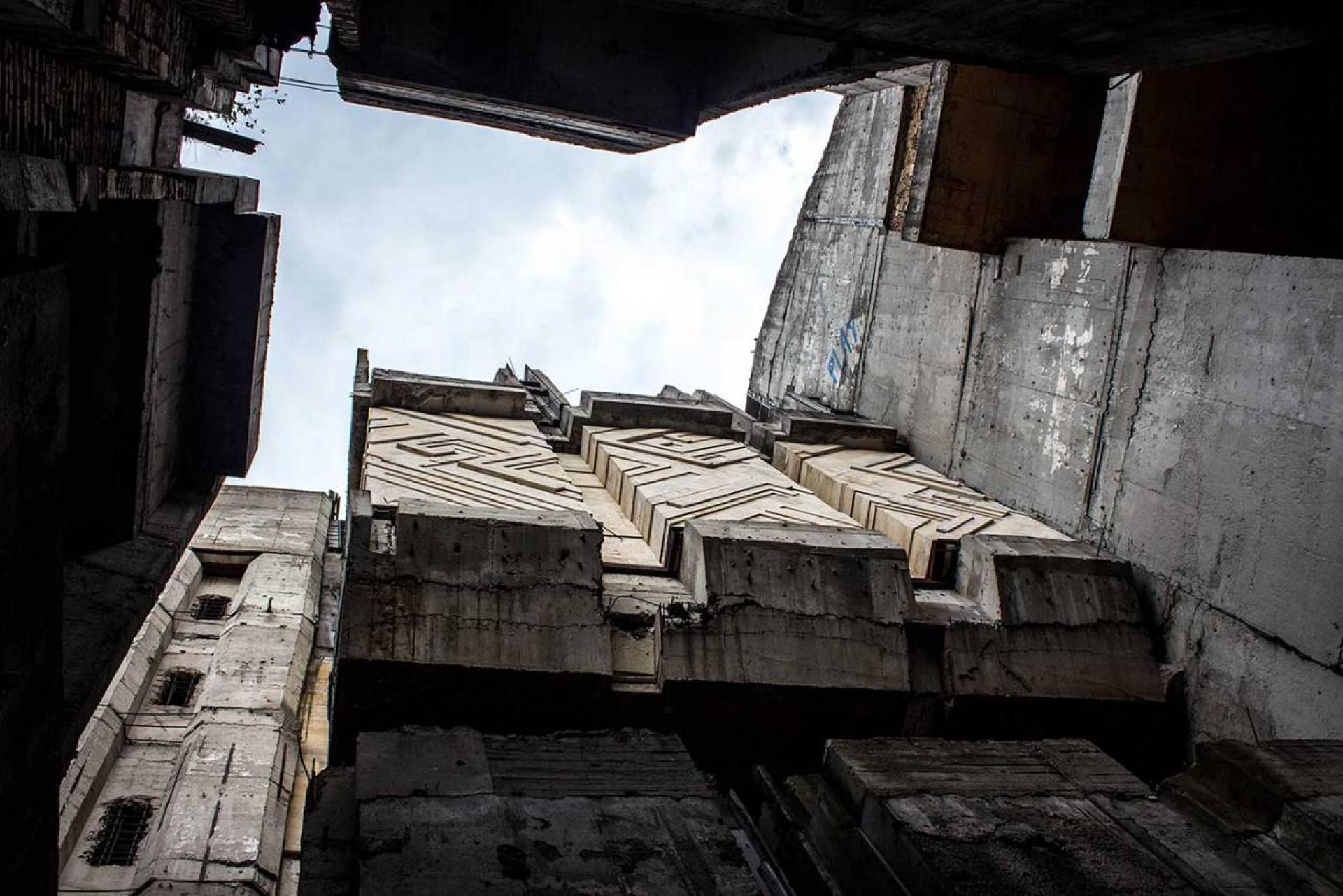
An upwards view, from deep within the abandoned construction site of the Central City Square concrete tower. | Photo © Darmon Richter
A vast concrete tower looms over Shumen’s city centre: phallic, foreboding, and visible from all ends of the city. Standing 18 storeys high, the tower rises from a construction site six storeys tall and spreading out to fill an entire city block. The Central City Square, a gargantuan experiment in urban design was intended to be revolutionary, incorporating shops, hotel, post office, cafes, restaurants, hall for weddings and rituals as well as municipal administrative offices but has never been finished.

Glimpsing the full scale of vast Central City Square. | Photo © Darmon Richter
When the Bulgarian Communist Party relinquished its single-party system at the end of 1989 the country slid into a chaotic and economically unstable democracy and many former state projects has been left incomplete. All over Bulgaria are the shells of abandoned construction projects, orphans of a dissolved government but nowhere any come close to the size of Shumen’s Central City Square. The tower, its most visible element, stood between two unfinished blocks which rise behind a security fence established right along the city’s central pedestrian area on Liberation Square. Only by peering over that fence, does one realise that the tower and both blocks are all the same building, joined through lower levels, dug into the hillside, with road access to the site from a street behind. The lower levels of Central City Square extend beneath the street, emerging behind you as tunnel entrances that look like metro stations. Hotel Madara, overlooking the square, was supposed to be connected with underground tunnels that would grant guests easy access to the complex.
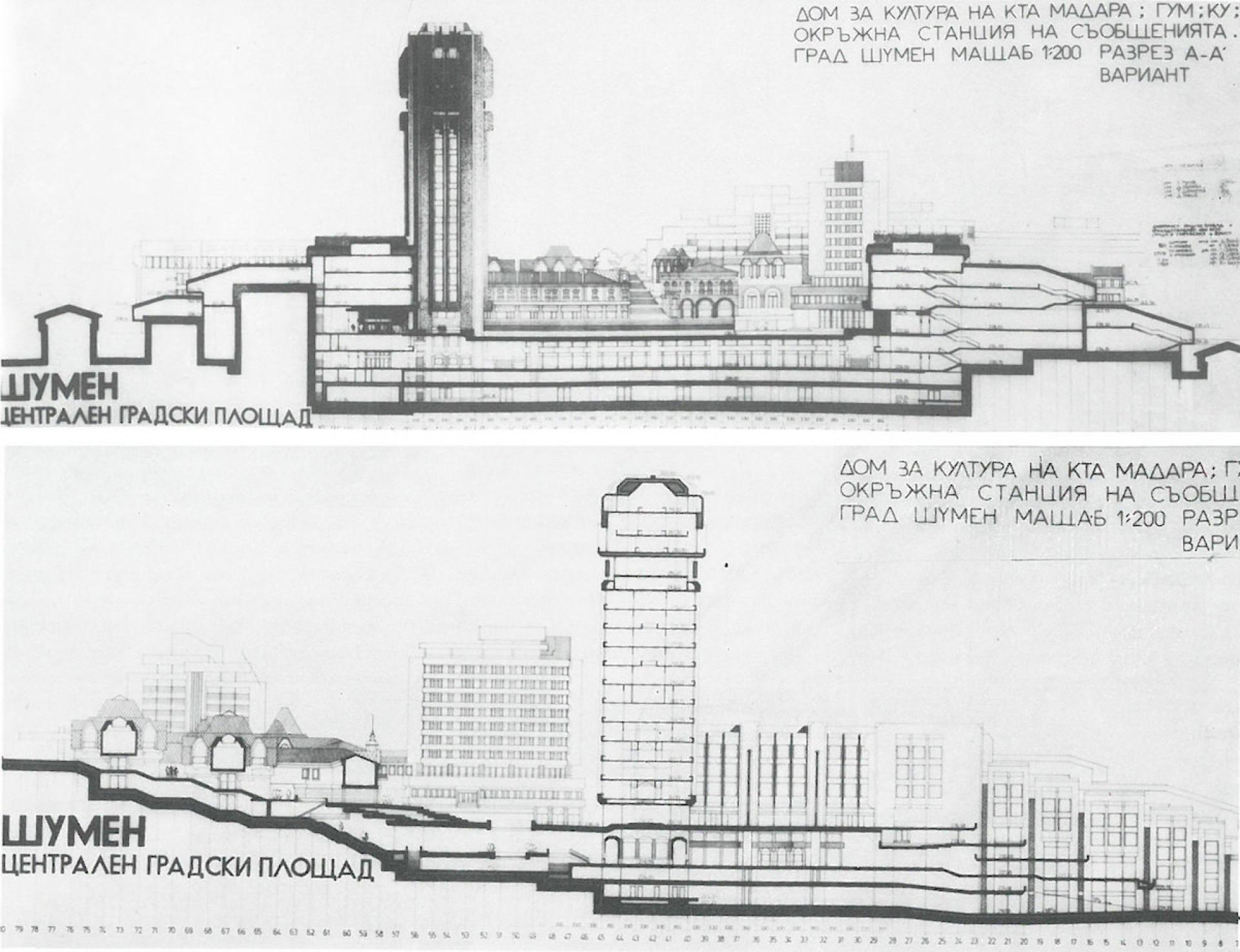
Cross sections of Shumen Central City Square. | Drawing via Promisljena estetika (1988) Vol. 1
The street was redeveloped in tangent with the Central City Square project, around the pedestrianised area are motifs thematically connecting it to both the new complex and the monument on the hill above. For instance, the tallest column of the Monument to the Founders of the Bulgarian State is topped with a stylised black granite lion, based on a 7th century carving, a design that is echoed in the streets below, with sculpted bronze lion heads set like sentries along a sheer concrete wall. Opposite the lions, the outer wall of the new complex nods to a culture that predates even the first Bulgarians, Hermes the messenger appears in sculpted relief on the face of what would have been the new post office.

A modernist relief at the subterranean entrance. | Photo © Darmon Richter
This redesign of Shumen city centre was a world apart from the monumental design of previous decades. Nearby, the 1949 Monument to the Red Army on Slavyanski Boulevard was pure, unadulterated socialist-realism; even the 1965 Monument to Freedom leant heavily into safe political territory with its hero figure and engraved hammer-and-sickle motif.

Western block rises behind an advertising fence.| Photo © Darmon Richter
However, the complex at the heart of this city project was bolder still. Intended to revolutionise Shumen’s urban landscape in ways that would have made this city notable not just by Bulgarian standards, but potentially one of the more advanced urban centres anywhere in the socialist world.
In an interview with Ivan Sivrev appeared in Industrial Aesthetics, Decorative Arts (1988), a monthly magazine published by the Bulgarian State Committee for Science and Technical Progress, the architect described the project as a forum for this 100,000-person city. “Central City Square has been designed as a living organism,” said Sivrev, “the elements of which are interconnected and interdependent just like, figuratively speaking, the organs of a living creature. We intend for Shumen’s centre to materialise as a synthesis between aesthetic, artistic, social, engineering, ecological and other requirements, instilling the rich historical past of Bulgaria into a modern development.”
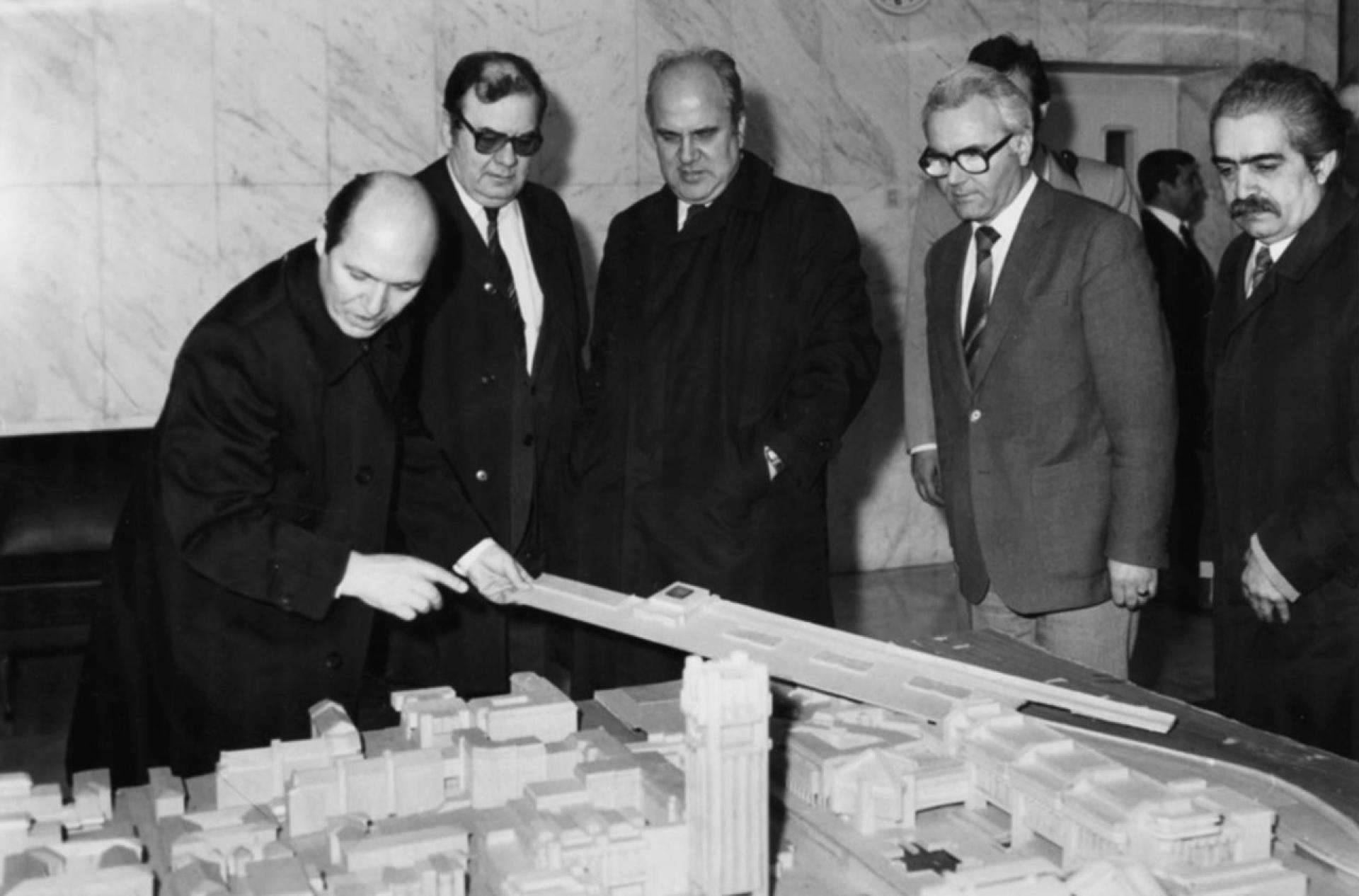
Ivan Sivrev (right) stands beside a model of Central City Square in 1988.
Sivrev lists the various facilities to be included in the complex “the ‘Man’s Industry’ Fashion House, ‘Pancho Vladigerov’ Festival Complex, the existing Hotel Madara, and on the first underground level, the House of Rituals and Services.” The Festival Complex alone was to feature “concert halls, a club house, recital halls, music rooms, a record shop and musical instrument outlets”, meanwhile, “the House of Rituals and Services consists of three ceremonial halls, a family centre and council offices where various administrative, legislative and technical services shall be provided. There shall be a conference hall with 400 seats and a club restaurant for the administrative workers.”

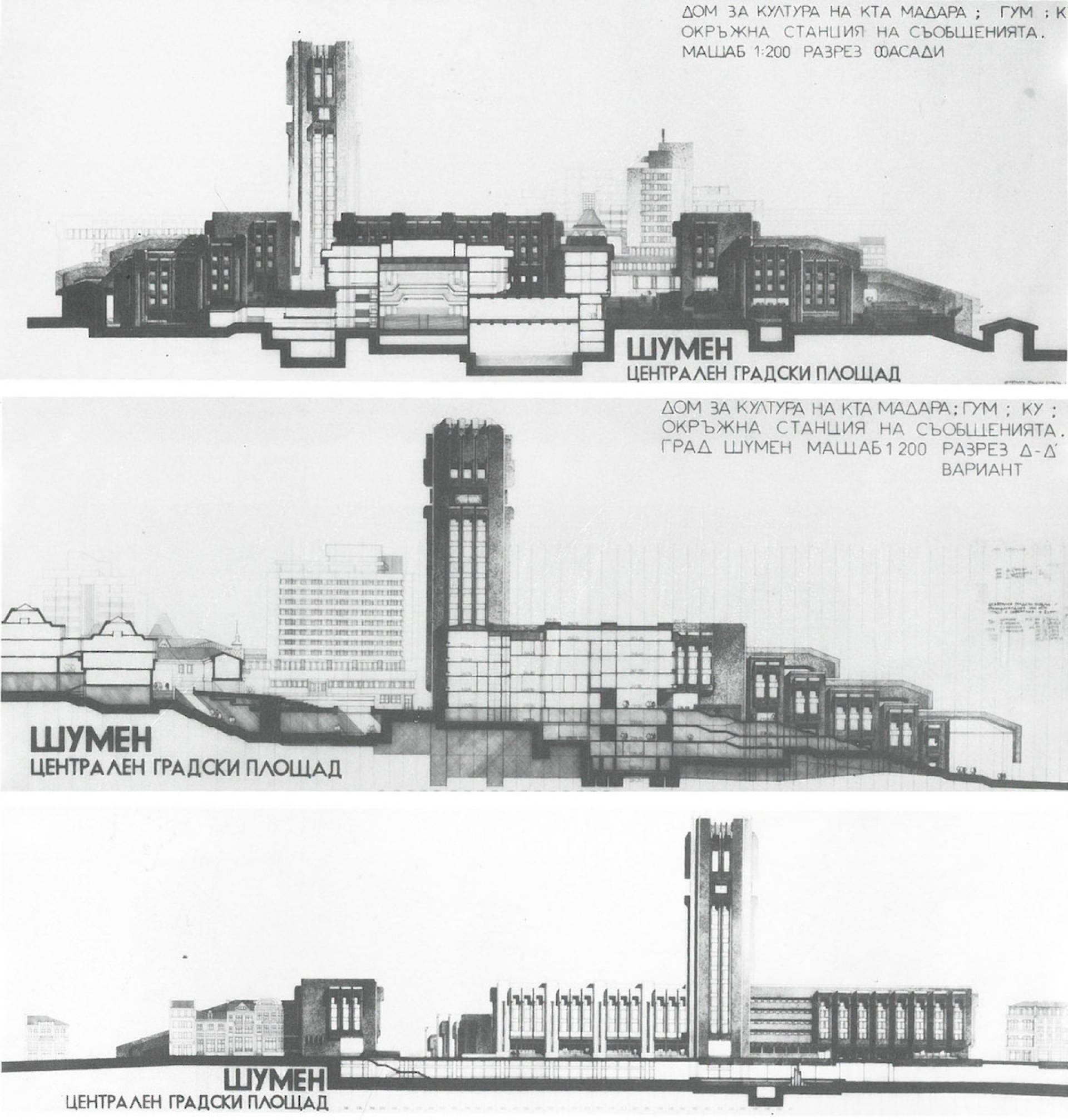
Preliminary (up left) and final (up right) building plan with silhouettes and cross sections (below). | Drawing via Promisljena estetika (1988) Vol. 1
Other outlets inside the building included tobacconists, pharmaceuticals, a panorama café, coffee shops, a luxury restaurant and nightclub for 250 guests. One particular theme that emerges from the interview is Sivrev’s commitment to environmental issues. The building was designed from the ground up with the goal of combatting congestion and pollution in the city; considerations which had been lacking from many of the Party’s previous large-scale constructions. The Shumen project was to feature open green spaces, rooftop gardens and planted terraces. It was planned with the intention of increasing the size of community green areas. Cascading water would provide a pleasantly refreshing spray in hot summers, while a unified public transport hub would free the neighbouring streets from traffic congestion.
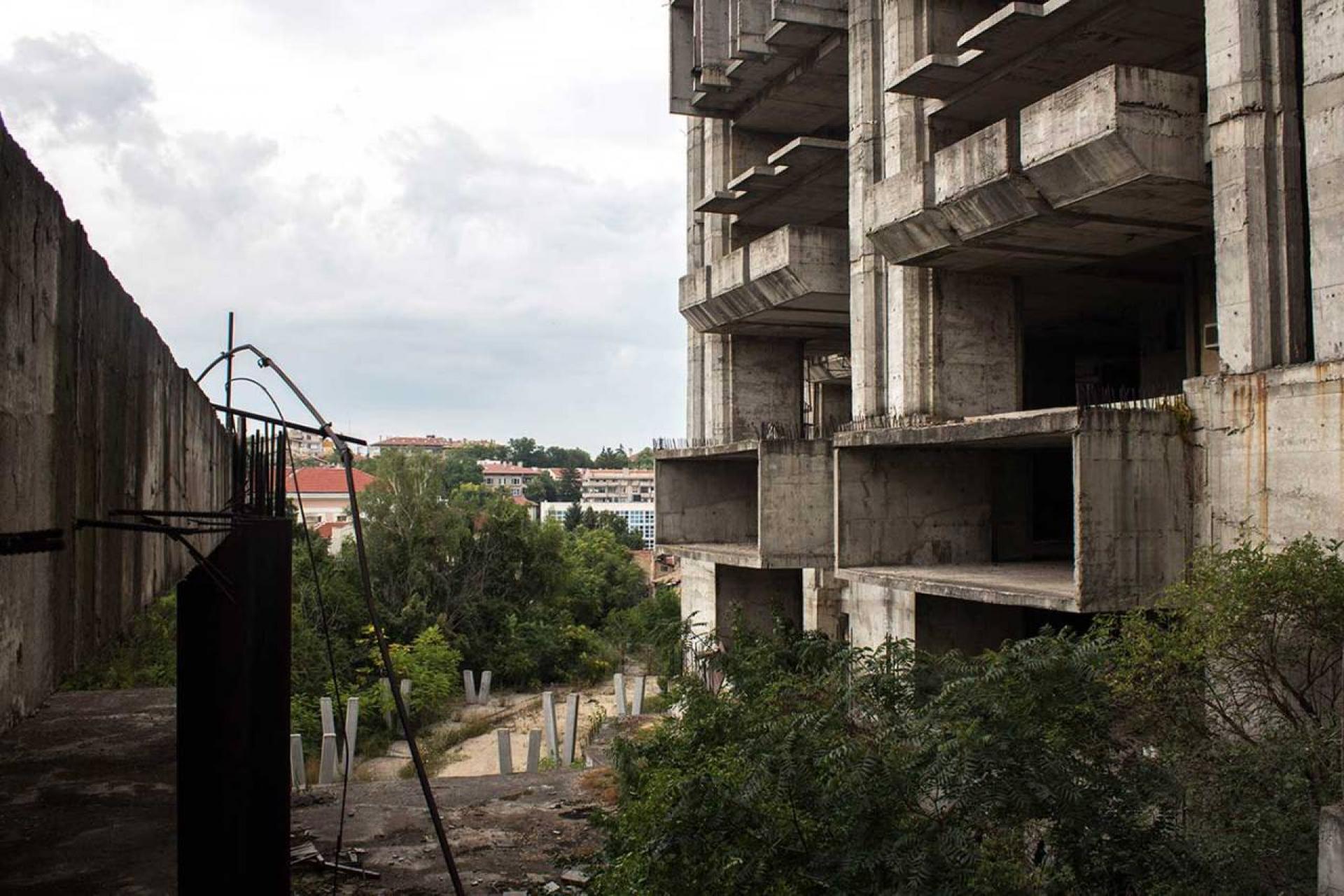
A towering concrete skeleton of the complex today. | Photo © Darmon Richter
This effect would be achieved by moving some of the city’s essential functions underground. “The construction of underground levels is a social necessity” states Sivrev as “underground levels bring mass transportation stops immediately next to the city square without creating a conflict between pedestrians and motor vehicles. They improve usage of public transportation significantly and reduce noise pollution and car emissions.”
The first underground level was planned for public transport stations, flower shops, souvenir and jewellery shops, homewares, perfumes, a national lottery kiosk and ticket offices for Balkan airline, BDZ rail company, Avtotransport coach company. The second underground level was intended to feature a car park for 200 vehicles under the square and a space for 250 vehicles next to Georgi Dimitrov Boulevard. Below that, the third underground level would provide a united storage area for servicing all buildings in the square.
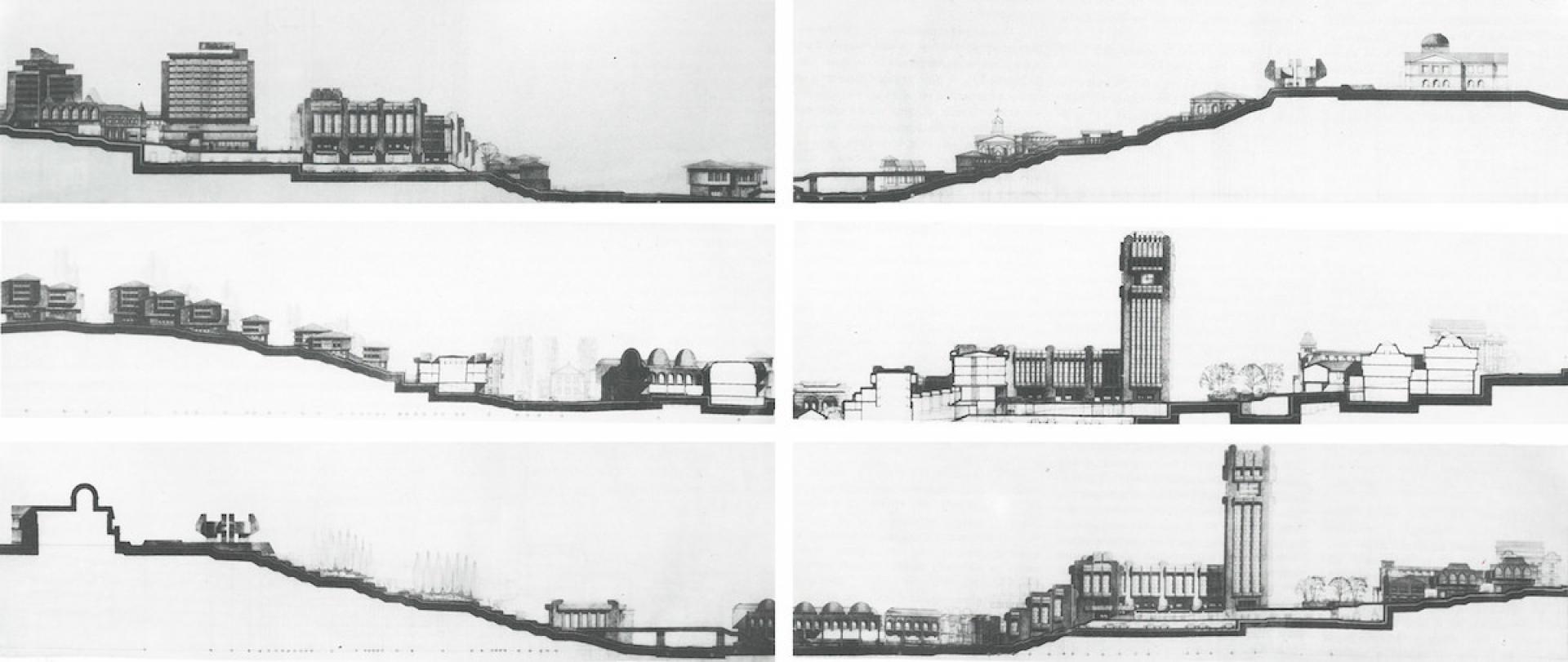
Silhouettes and cross sections along the main core axes of the central structure. | Drawing via Promisljena estetika (1988) Vol. 1
The project as a whole reflected new ways of thinking about urban space. There are parallels between Ivan Sivrev’s design and the Radiant City proposed by Le Corbusier in 1930, when he exhibited his design for the perfected future metropolis - a linear city formed of standardised blocks, with underground transit routes reducing the surface traffic to allow for an abundance of green spaces. Each block would take the form of a self-contained vertical village containing shops, laundries, even kindergartens. The architect likened his vision to a living organism, composed of interconnected organs working together in harmony.

Le Corbusier’s proposed extent of the Radiant City. | Photo via Stadtstreicher
“I believe we managed to achieve conceptual synergy between urbanisation and architectural-artistic concepts. The development and its attributed buildings create the necessary conditions and allow for creating a unified architectural organism in which all levels and structures are both spatially and functionally connected. This is the very first such development in Bulgaria and it applies the most advanced principles of underground urbanism” is certain Sivrev. His design sketches show that the plan for Shumen Central City Square would have seen it grow considerably larger than what’s visible today. Much like Le Corbusier’s Radiant City the project would remain unrealised and today, those who venture inside will find not utopia, but a sprawling warren of abandoned spaces and twisting concrete corridors.

Unfinished spaces on the easternmost block. | Photo © Darmon Richter

Plants have taken root in some of the airier regions of the complex. | Photo © Darmon Richter
Bulgaria’s communist leader Todor Zhivkov was kicked out by his own party in 1989 in response to a number of growing criticisms throughout the final years of his regime. The rise of nationalism had been a major factor, culminating in Zhivkov’s attempted ethnic cleansing of Turkish and Roma minorities, beside that there had also been serious environmental concerns. Zhivkov had continued his predecessors’ urbanisation schemes, with large-scale industrialisation as cities were rapidly expanded to accommodate new work forces. The state had done little, however, to offset the effect this was having on the environment. By 1989, The Ledger reported that 85% of Bulgaria’s river water and 70% of its farmland had been damaged by industrial wastes and pollutants.
The Danube city of Ruse had it worst of all, when a chemical plant was built across the river at Giurgiu in Romania, it began to exhale toxic gases towards Bulgaria. Soil around the Ruse area was shown to contain concentrations of mineral acid at 40 times over the safe limit. A cloud of chemical gas descended on a Ruse meeting of the Young Pioneer organisation in September 1987, and children as young as seven were seen choking, running for cover with their red neckerchiefs clutched over their mouths. Zhivkov refused to act, however, unwilling to upset his fraternal relationship with the Romanian dictator Nicolae Ceaușescu. The Committee for the Ecological Protection of Ruse was founded, and they began protesting Zhivkov’s lack of solutions. Initially these demonstrations were crushed, Zhivkov allegedly ordered the beating of a group of environmental activists outside an OSCE summit in October 1989, but national dissatisfaction grew. Organised, nationwide protest gave birth to the Ecological Openness movement: a forerunner to the contemporary Bulgarian Green Party.
As Detlef Pollack and Jan Wielgohs note in Dissent and Opposition in Communist Eastern Europe, “On November 3 1989, Ecoglasnost (Ecological Openness) delivered the crucial blow to the Communist political system. At least 10,000 people came and marched to parliament, carrying posters and chanting the word democracy. It was a crucial breakthrough. Just a week following the Ecoglasnost march, Zhivkov was sacked.”

Bare concrete facades on the north side. | Photo © Darmon Richter
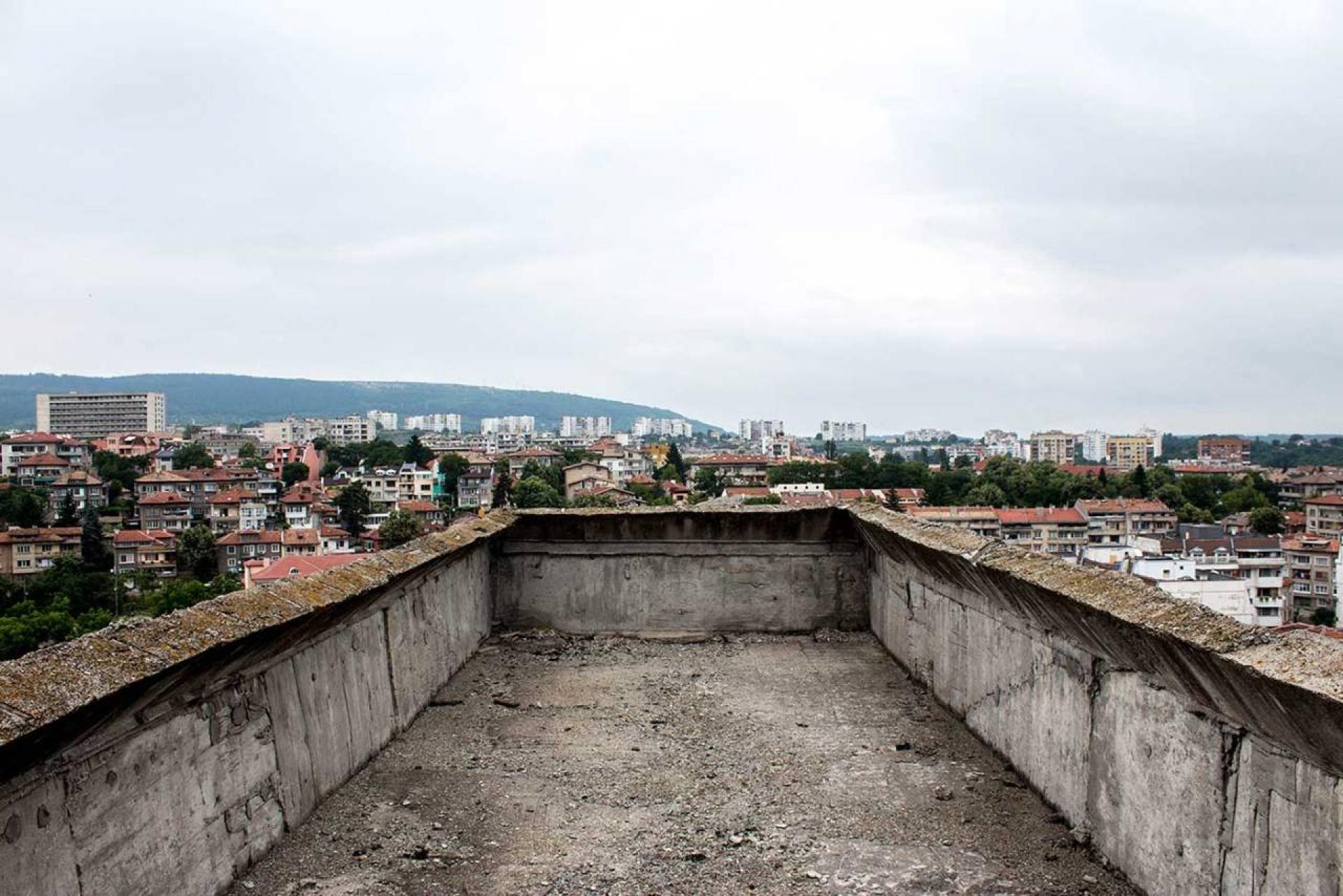
Shumen from the rooftops. | Photo © Darmon Richter
Perhaps Shumen’s Central City Square, a Corbusian city of the future, designed for a new ecologically responsible mode for urban living, had been a belated response to the problems. Perhaps it was intended as a trial, as the first of a new wave of ecologically-friendly urban redevelopments, but even if that were the case it was too little, too late.
Even by 1988, the project had reportedly been fraught with difficulties and by disagreements amongst its creative team. Sivrev explained these as “the inability to comprehend the unity and yet simultaneously multi-faceted nature of the development.” One engineer had baulked at the prospect of building the tower and ran away from the project. “Atypical solutions require atypical thinking” Sivrev concluded.
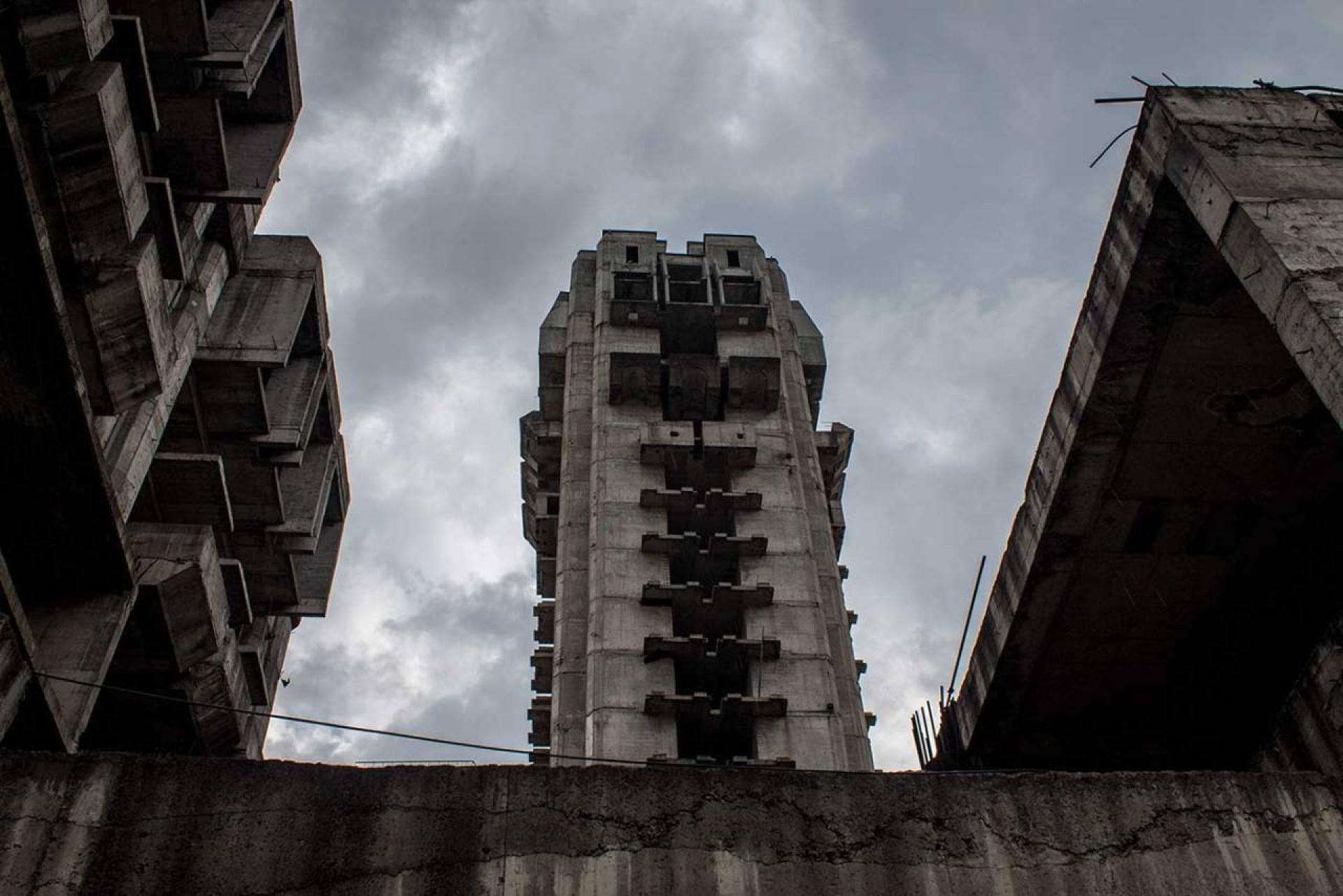
The unfinished tower. | Photo © Darmon Richter
But the final blow came in 1989 when the communist state was dissolved and Shumen’s Central City Square, like so many other unfinished constructions in Bulgaria, had its funding cut off. In place of a unified architectural organism the people of Shumen would be left instead to deal with a colossal, crumbling skeleton.
–
by Darmon Richter [Adapted with permission from Ex Utopia]